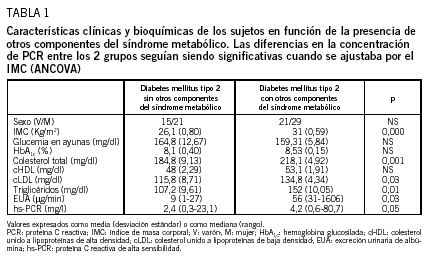Información de la revista
Vol. 124. Núm. 9.
Páginas 336-337 (marzo 2005)
Compartir
Descargar PDF
Más opciones de artículo
Vol. 124. Núm. 9.
Páginas 336-337 (marzo 2005)
DOI: 10.1157/13072422
Factores que influyen en la concentración plasmática de proteína C reactiva en la población diabética
Factors influencing CRP levels in the diabetic population
Visitas
2625
Este artículo ha recibido
Información del artículo
Fundamento y objetivo: Determinar los factores que influyen de forma independiente en la concentración sérica de proteína C reactiva (PCR) en la población diabética. Pacientes y método: Se incluyó de forma prospectiva a 86 pacientes con diabetes mellitus tipo 2. Las variables consideradas fueron: edad, sexo, hábito tabáquico, índice de masa corporal (IMC), glucemia, HbA1c, perfil lipídico, excreción urinaria de albúmina, PCR y E-selectina. Resultados: Las concentraciones de PCR se relacionaron con: sexo (varones [mediana y rango], 1,4 mg/l [0,03-12,8] frente a mujeres, 3,4 [0,07-80,7]; p = 0,02), edad (r = 0,34; p = 0,001), IMC (r = 0,45; p < 0,001), triglicéridos (r = 0,24; p = 0,03), y E-selectina (r = 0,21, p = 0,02). Los pacientes con algún componente del síndrome metabólico presentaron mayores concentraciones de PCR que los pacientes sin otros componentes (2,4 mg/l [0,3-23,1] frente a 4,2 mg/l [0,6-80,7]; p = 0,05). En el análisis de regresión múltiple se observó que las variables independientemente asociadas a la concentración sérica de PCR eran el sexo (p = 0,001) y el IMC (p = 0,01). Conclusiones: El sexo y el IMC son las variables más importantes que hay que tener en cuenta cuando se estudia la PCR en la población diabética. En los pacientes con diabetes mellitus tipo 2 las concentraciones séricas de PCR aumentan con la presencia de otros componentes del síndrome metabólico.
Palabras clave:
PCR
Diabetes mellitus tipo 2
Índice de masa corporal
Síndrome metabólico
Background and objective: The aim of the present study was to investigate the factors influencing CRP serum levels in the diabetic population. Patients and method: Eighty-six patients with type 2 diabetes mellitus were prospectively included. The following variables were considered: age, gender, smoking habit, body mass index (BMI), glucose, HbA1c, total cholesterol, low density lipoprotein-cholesterol (LDL-C), high density lipoprotein-cholesterol (HDL-C), triglycerides, albumin excretion rate, CRP and E-selectin. Results: CRP serum levels were associated with: gender (men: 1.4 mg/L [0.03-12.8] vs. women: 3.4 [0.07-80.7]; p = 0.02), age (r = 0.34, p = 0.001), BMI (r = 0.45, p < 0.001), triglycerides (r = 0.24, p = 0.03) and E-selectin (r = 0.21, p = 0.02). Those patients with at least one component of the metabolic syndrome, besides diabetes mellitus, had higher CRP concentrations in comparison with those patients without other components of the metabolic syndrome (2.4 mg/L [0.3-23.1] vs. 4.2 mg/L [0.6-80.7]; p = 0.05). In the multivariate analysis, gender (p = 0.001) and BMI (p = 0.01) were independently associated with the CRP concentration. Conclusions: Gender and BMI are the main factors to be considered when analyzing CRP levels in the diabetic population. Metabolic syndrome components other than diabetes are related to CRP levels in type 2 diabetic patients.
Keywords:
CRP
Diabetes mellitus type 2
Body mass index
Metabolic syndrome
Opciones para acceder a los textos completos de la publicación Medicina Clínica
Suscriptor
Suscribirse
Comprar
Contactar
Teléfono para suscripciones e incidencias
De lunes a viernes de 9h a 18h (GMT+1) excepto los meses de julio y agosto que será de 9 a 15h
Llamadas desde España
932 415 960
Llamadas desde fuera de España
+34 932 415 960
E-mail







